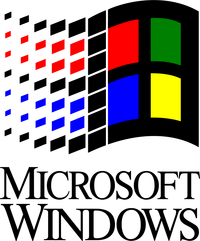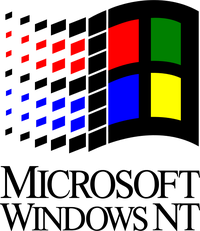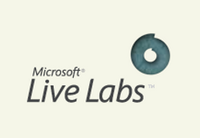Clipart for Windows Art Factory Cd Rom Liestyle Windows 1996
- This article is about the desktop-oriented operating system for computers. For other Windows-branded products and brands, see Microsoft Windows (disambiguation).
| Contents | |||||
|---|---|---|---|---|---|
| | | | | | |
| 1985–2001 | 1990–2001 | 1992–2008 | 1993–2001 | 1994–2001 | 1995–2001 |
| | | | | | |
| 1996–2004 | 1998–2006 | 1999–2010 | 2000–2006 | 2001–2014 | 2006–2017 |
| | | | | | |
| 2009–2020 | 2012–2016 | 2013–present | 2015–present | 2021–nowadays | |
Windows i.0/2.0
1985–2001
|
Windows one.0 and 2.0 were the beginning versions of Windows. These versions were only to add together a visual guide to MS-DOS. The logo slightly resembles the Windows viii, 8.1, ten and 11 logo, except that the vertical lines are in different places. Support ended on December 31, 2001.
Windows iii.0
1990–2001

|
|
The original blue logo was removed and replaced with a darker logo with a black-and-white gradient that looks more similar a window. Windows 3.0 was the version that offset introduced Program Manager (predecessor of Start Menu and Taskbar), which fabricated information technology popular considering information technology was easier to use than 1.0 and 2.0. This logo was seen on some software boxes to denote compatibility with Windows 3.0,[one] only rarely seen anywhere on actual OEM products for Windows three.0 itself. Windows 3.0's back up ended on December 31, 2001.
Windows 3.1x
1992–2008

|
|
|
Windows 3.1 was an updated version of Windows 3.0, with several enhancements to the still DOS-based platform, including improved organization stability, expanded back up for multimedia, Truetype fonts, and workgroup networking. The iconic four colored Windows logo was introduced with Windows 3.1. The rest of the 3.1x series included Windows 3.xi, Windows 3.2 and Windows for Workgroups, where slight changes were made to the colors of the logo. This logo also would take a trail backside information technology. Support for the Windows 3.1x line of operating systems concluded on Dec 31, 2001, except for WFW 3.11 embedded, in which support ended on Nov 1, 2008.
On Twitter, Microsoft cites Jeff Boettcher as the designer of the original Windows flag.[2] Jonathan D. Cowles, art director at Microsoft from 1991 to 1994, cites himself as designer of the original Windows flag, under the supervision of Boettcher and Julie Wong.[3]
Windows NT 3.1
1993–2001

|
|
Windows NT 3.1, the starting time version of Windows NT and first 32-bit Windows, was released on July 27, 1993. This version was based on the 3.1 desktop environment, and came with two editions: Windows NT three.ane for Workstation and Windows NT 3.one Advanced Server. This logo is mostly the same as the iii.1x logo, just with some slight differences including shading on the blocks and flag, the size of the "MICROSOFT WINDOWS" text being changed, and the "NT" text beingness added. Support for Windows NT 3.ane ended on December 31, 2000, forth with mainstream back up for Windows 95, becoming the get-go operating system in the Microsoft Windows line to phase out back up.
Windows NT 3.5x
1994–2001

|
|
Windows NT iii.5 was released on September 21, 1994, and Windows NT 3.51 was released on May xxx, 1995. Like its predecessor, both versions had the same desktop environment from 3.ane and NT 3.ane; they also came with Server and Workstation editions. For this logo, the flag was tilted to the right (as it would be for near hereafter appearances until the release of Windows XP), the "WINDOWS" text became larger, the "Microsoft" text is no longer in all caps and placed to the left. Back up for Windows NT iii.5 and 3.51 ended on December 31, 2001 (Windows NT 3.51 Server Edition concluded on September 30, 2002).
Windows 95
1995–2001

|
|
Windows 95 was released on August 24, 1995, with several new features, mainly the graphical user interface, the First Bill of fare, Windows Explorer, and the taskbar; it was the first operating organization in the 9x family unit. MSN was likewise launched on the same twenty-four hours. Windows 95 too introduced a redesigned vanquish based around a desktop metaphor; the desktop was repurposed to hold shortcuts to applications, files and folders, reminiscent of Mac OS. The "Microsoft Windows" text changed fonts, "Windows" is no longer in all caps (and is also in a bolder font), "Microsoft" is no longer on the left of the "Windows" text. Extended support concluded on December 31, 2001 (mainstream back up ended on December 31, 2000).
Windows NT 4.0/NT 5.0
1996–2004

|
Windows NT 4.0 was released on July 31, 1996, and for full general availability on Baronial 24, 1996, the aforementioned day every bit Windows 95 OSR 2. This version brought the desktop environment and several features from Windows 95, and had five editions: Workstation, Server, Enterprise Edition, Final Server Edition, and Embedded. This logo is generally the same as Windows 95, but with "95" replaced with "NT". Extended support concluded on June 30, 2004 (mainstream support ended on June 30, 2002).
Windows 98/98 SE
1998–2006

|
Windows 98 was released on June 25, 1998. In May 1999, Microsoft released Windows 98 SE (2d Edition, incorrectly referred to as Windows 99) which stock-still certain bugs and issues from Windows 98 but didn't accept an official logo. The logo is the aforementioned as Windows 95, but "95" was replaced with "98". Extended support ended on July 11, 2006 (mainstream support concluded on June 30, 2002). This fabricated it the showtime MS-DOS based version of Windows to exist supported to any appointment other than December 31, 2001.
Windows 2000
1999–2010

|
|
Windows 2000 was outset released for business customers on December 17, 1999, and for general availability on Feb 17, 2000. The organisation is NT-based, non function of the 9x serial, and was used both for server computers and regular computers. Windows 2000 brought many features and improvements from Windows 9x. The flag is still there, only now at that place are 5 windows, four of which are blue and white (with the flag being in the window in the front), and the i in the bottom left being orangish and red. Extended support concluded on July 13, 2010 (mainstream back up ended on June 30, 2005).
Windows Me
2000–2006

|
Windows ME, released on September fourteen, 2000, is i of the worst-received versions of Windows, as it was known to crash too often and contained several bugs; equally a consequence, its usage is extremely uncommon among Windows users. ME was as well the last version of Windows 9x, which was based on MS-DOS (because of this, it was also the last version to have support for almost MS-DOS games). There are still the windows in this logo, but now there are only three: an orange one in the back, a blue one in the eye, and a green 1 in the forepart (which had the flag in it). Instead of proverb the year, information technology says "Me" in a script font with "Millennium Edition" nether it. Extended support for Windows ME concluded on July 11, 2006, alongside Windows 98 (mainstream support for ME concluded on December 31, 2003).
Windows XP
2001–2014

|
|
In 2001, Microsoft overhauled the Windows logo once more, giving it a more clean experience. The Windows logo was simplified, removing the black borders and squares flowing behind it, and given a "plastic" experience to match the interface of Windows XP. It used the Franklin Gothic Medium font for the text.
Windows XP was released on October 25, 2001, beingness the commencement version of the consumer edition based on NT, and introduced a new look and experience to the desktop and the majority of the system in full general, with its Luna theme and several new features. Information technology was known to be the longest-supported version of Windows, and was 1 of the almost popular versions of the operating system.
Information technology was as well the last version to accept support for MS-DOS. Extended back up ended on Apr 8, 2014 (mainstream back up ended on April 14, 2009).
Windows Vista
2006–2017

|
In mid-2005, Microsoft modified their 2001 logo to add a glow in the center and changed the font to Segoe. The "Microsoft" text was besides removed from the logo.
Windows Vista was initially released for business concern customers on Nov 30, 2006, and for general availability on January 30, 2007. The system was criticized due to high requirements and certain bugs. While Windows Vista was also turned down by many, it introduced new features and blueprint tweaks, including the Aero design linguistic communication, Sidebar and Widgets, Windows Defender, 3D Task Switcher, Welcome Center, and Games Explorer. Extended support ended on Apr 11, 2017 (mainstream back up concluded on Apr 10, 2012).
Windows seven
2009–2020

Windows vii kept the same blueprint and logo from Windows Vista, aside from the text being changed to read the number 7.
Windows seven was released on Oct 22, 2009, and was better received than its predecessor, introducing features such as the redesigned taskbar, Windows Snap, HomeGroup, libraries for documents, audio, videos, etc. Mainstream support concluded on January thirteen, 2015, and extended support concluded on January 14, 2020. Pro, Enterprise and Ultimate users tin can pay for support until Jan ten, 2023.
Windows 8
2012–2016

|
|
Microsoft overhauled their logo again to fit in with the new Metro design language on Windows 8, which removed the colors to become all bluish and introduced a slightly modified Segoe font. This logo was unveiled on Windows eight Consumer Preview, released in February 2012. Notably, this logo ditched the flag design that had been used since 2001, also equally the three-dimensional Aero theme, replacing information technology with a simple window tilted to the left, designed by Pentagram.
Windows 8 was released on October 26, 2012, and introduced features such equally the new Start screen, the Charms, apps, and touchscreen back up for devices such every bit the new Surface tablet. However, it received a mixed reception, with many criticizing it equally being unintuitive compared to its predecessor and questioning Microsoft's push button to expand the Windows line to touchscreen devices. Windows 8 is known for existence the shortest-supported version of Windows, having had its support terminate on January 12, 2016 (to regain support, users are recommended to upgrade to Windows eight.i, which tin exist done on this version without an installation disc).
Windows 8.1
2013–present

|
On October 17, 2013, Microsoft released Windows 8.one, which addressed certain criticisms of Windows 8 and also featured certain improvements, such equally the improved Start screen, boosted Snap views, and the restoration of a visible Start button on the taskbar. This logo is substantially the same as Windows viii, but with a thinner font; however, information technology was not officially used past Microsoft in advertising (where the default Windows logo was used) nor in the OS (where the Windows viii logo was used), then it was seldom seen. Mainstream back up ended on January nine, 2018, and extended support will end on January 10, 2023.
Windows x
2015–present

Microsoft officially unveiled the offset beta version of Windows x on September xxx, 2014. The text on the wordmark of the logo was unbolded and the logo itself was made a darker shade of blueish. The showtime version of the operating system was released worldwide on July 29, 2015. Since then, Windows ten releases new feature updates twice per year (except in 2016). Windows ten'due south new features include the return of the Commencement menu, new versions of Microsoft Store-based apps, multiple desktops, vocalisation assistant Cortana, and the new internet browser Microsoft Edge. New updates include Game Style, Paint 3D and the new Fluent Design language, which replaced Metro.
Support for Windows 10 will end on October 14, 2025.
Windows eleven
2021–present

|
This logo was outset leaked on June 15, 2021, and became official when Microsoft announced Windows 11 on June 24. This logo is very similar to the Windows 95 commercials from the mid 90s, the Microsoft Store logo from 2009, and Microsoft's 2012 logo, but retains the colour of Windows 10'south logo. The Segoe UI font has besides changed to a assuming weight.
Windows 11 was released on October v, 2021.
References
- ↑ 1.0 i.one "3rd-party support for Microsoft Windows v. three.0". One to One with Microsoft (December 1990).
- ↑ 2.0 2.1 "Heighten your flags! Jeff Boettcher designed the Windows flag logo #wintrivia ^JAS". Twitter (Apr 26, 2011). Retrieved on April vi, 2022.
- ↑ 3.0 3.1 "Jonathan Cowles". LinkedIn. Retrieved on April 6, 2022.
- ↑ frogdesign.com - The confront of the new Windows: inviting to the bear upon
- ↑ CaseyPotterDesign.com - Windows XP
External links
- Official website
| V• T • E Windows | ||
|---|---|---|
| Current Windows (Holographic | IoT | Server | 365) | One UI Book1
Defunct/Deprecated 1 Adult by Samsung; software skin for Galaxy Book series |
| V• T • E Microsoft | ||||||||||||||||||||||||||||||||||||||||||||||||||||
|---|---|---|---|---|---|---|---|---|---|---|---|---|---|---|---|---|---|---|---|---|---|---|---|---|---|---|---|---|---|---|---|---|---|---|---|---|---|---|---|---|---|---|---|---|---|---|---|---|---|---|---|---|
| Apps, Software and Web Services microsoft.com | Authenticator | Bing (Maps) | Cortana | Border | GroupMe | Launcher | Movies & Television receiver | Outlook.com (Agenda | Tasks) | Skype | To-Do
Business Development Gaming
Hardware
Conventions Other
Defunct/Discontinued
|
Source: https://logos.fandom.com/wiki/Microsoft_Windows

















0 Response to "Clipart for Windows Art Factory Cd Rom Liestyle Windows 1996"
Post a Comment